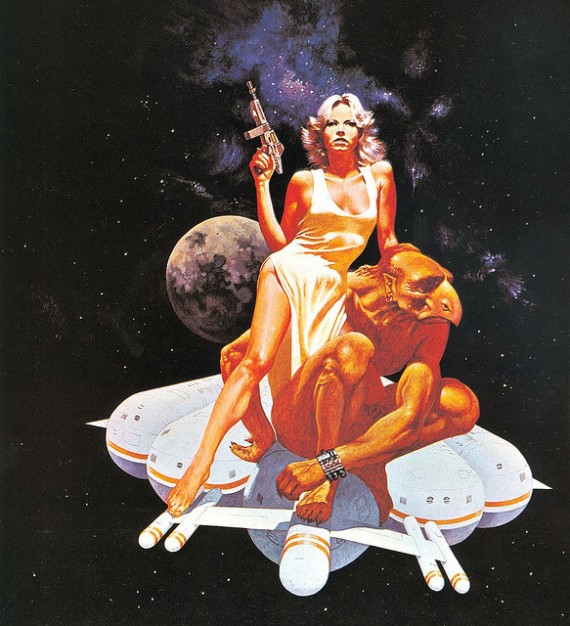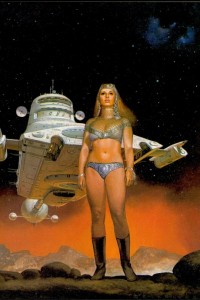 Let’s have some fun. Let’s live dangerously. Let’s run with scissors. Let’s open up an umbrella indoors. Lets judge some books by their covers!
Let’s have some fun. Let’s live dangerously. Let’s run with scissors. Let’s open up an umbrella indoors. Lets judge some books by their covers!
 Judging a book by its cover is not wise, but we do it all the time, particularly when the cover art is so striking. In an earlier column I wrote about the heyday of the science fiction paperback. Since then I have been going through my old collection of older science fiction and fantasy paperbacks to see what gems are hidden there.
Judging a book by its cover is not wise, but we do it all the time, particularly when the cover art is so striking. In an earlier column I wrote about the heyday of the science fiction paperback. Since then I have been going through my old collection of older science fiction and fantasy paperbacks to see what gems are hidden there.
BABEL 17 was written in 1966 by Samuel R. Delany. It was joint winner of the Nebula Award for Best Novel in 1966 and was also nominated for the Hugo Award for Best Novel in 1967. It explores the hypothesis that language influences thought and perception.
During an interstellar war one side develops a language, Babel-17, that can be used as a weapon. Learning it turns one into an unwilling traitor as it alters perception and thought. The change is made more dangerous by the language’s seductive enhancement of other abilities. This is discovered by the beautiful starship captain, linguist, poet, and telepath Rydra Wong. She is recruited by her government to discover how the enemy are infiltrating and sabotaging strategic sites. Initially Babel-17 is thought to be a code used by enemy agents. Rydra Wong realizes it is a language, and finds herself becoming a traitor as she learns it.
 The edition that I read was an Ace edition from 1979 and featured cover art by artist David Bergen that is eye-catching if not actually representative of what is described in the text. A beautiful blond woman holding a space gun and wearing an evening gown that shows a lot of leg leans atop a crouching beaked creature (presumably a minor character from the book called Griffon). Both figures stand atop a rather unimaginative, though highly symetrical spaceship against a background of planets and stars.
The edition that I read was an Ace edition from 1979 and featured cover art by artist David Bergen that is eye-catching if not actually representative of what is described in the text. A beautiful blond woman holding a space gun and wearing an evening gown that shows a lot of leg leans atop a crouching beaked creature (presumably a minor character from the book called Griffon). Both figures stand atop a rather unimaginative, though highly symetrical spaceship against a background of planets and stars.
The woman is meant to be the main character, poet. linguist and government code-breaker Rydra Wong. This is only an assumption. The woman depicted looks more like Farrah Fawcett than the character as described by Delany.
For one, she is not depicted as asian which would be a natural assumption from her name. Perhaps that reflects a cultural bias, but the original Ace paperback edition did depict her just that way and, as Delaney does not say otherwise, it would be safe to assume that the character would have an asiatic look. The original Ace edition art was by an artist named Jerome Podwil
 Babel 17 has been in print almost constantly since its initial publication and has sported many covers each with varying degrees of success. And range from the lurid (like the Bantam edition cover by Vincent Segrelles which depicts the main character, again as Nordic, in a desultory pose and wearing a science fiction bikini) to the restrained (A French Language edition which depicts the main character’s face superimposed on a starfield while a space battle happens in front of her).
Babel 17 has been in print almost constantly since its initial publication and has sported many covers each with varying degrees of success. And range from the lurid (like the Bantam edition cover by Vincent Segrelles which depicts the main character, again as Nordic, in a desultory pose and wearing a science fiction bikini) to the restrained (A French Language edition which depicts the main character’s face superimposed on a starfield while a space battle happens in front of her).
The book lends itself well to traditional science fiction art. The main character is a beautiful woman, the secondary characters, while not alien, have drastic body modifications, and there are spaceships and space battles as well as the concepts of altered perceptions brought about by learning an alien language. All this is fodder for cover artists from the pulp-inspired to the avante garde and all stops in between.
BABEL 17, though not a long book, is fascinating and chock full of great scenes, characters and ideas and although many covers have adorned its many editions, none of them truly do it justice.
Next week I am going to dissect some more science fiction and fantasy cover art. Michael Moorcock’s THE SILVER WARRIORS as well as Michael Coney’s THE JAWS THAT BITE, THE CLAWS THAT CATCH, will be on the bill as well as, perhaps, one or two others.
A Gallery of Babel-17 covers:




























I enjoyed your article, MD. By contrast, here’s a completely nondescript cover (which is the one I think I read as a teenager): https://www.jwkbooks.com/pictures/8955.jpg
Hah! You can’t get much more nondescript than that!